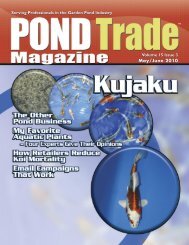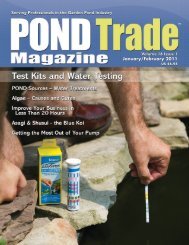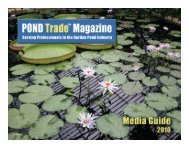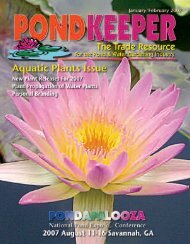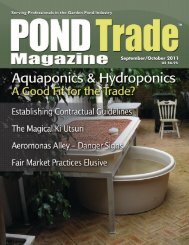Download the January/February 2010 PDF - Pond Trade Magazine
Download the January/February 2010 PDF - Pond Trade Magazine
Download the January/February 2010 PDF - Pond Trade Magazine
You also want an ePaper? Increase the reach of your titles
YUMPU automatically turns print PDFs into web optimized ePapers that Google loves.
company...which managed to endure for an amazing 12 year run.<br />
Additionally, Steve designed and/or co-designed a number of<br />
aquatic plant containers shortly after transitioning <strong>the</strong> industry<br />
from "Tucker Tubs" to professional, no-hole nursery containers,<br />
and subsequently developed new growing<br />
protocols around <strong>the</strong>m for commercial<br />
aquatic plant growers.<br />
He's written extensively for various<br />
periodicals, and has co-authored three<br />
books on <strong>the</strong> care and cultivation of<br />
aquatic plants. He currently holds<br />
national sales rep positions with Americo<br />
Manufacturing [Poly Flo] & Loki Nets. He also consults<br />
within <strong>the</strong> industry and occasionally teaches aquatic plant<br />
classes at industry events as well as furnishes aquatic plant tech<br />
support to various organizations on behalf of <strong>the</strong> IWGS. At<br />
present, he holds <strong>the</strong> office of Vice President of <strong>the</strong> IWGS,<br />
where he also functions as occasional fundraiser and Facebook<br />
administrator. Heís an infrequent contributor to industry<br />
trade publications, but often functions as a de facto industry<br />
satirist and critic.<br />
Steve enjoys rural living, rock & roll, vegetable gardening,<br />
cheap wine, vintage military firearms, growing waterlilies,<br />
canoeing, fossil collecting, housewifery, and alligator<br />
wrestling. He resides on 15 wooded acres in rural Alabama<br />
with his indulgent and forgiving wife, five cats, an<br />
indeterminate number of western cottonmouths, and<br />
hundreds of aquatic plants.<br />
Question<br />
I have a question for you regarding plants that can grow in<br />
and out of a pond, like horsetail. I have purchased horsetail<br />
from local nurseries and tried to put <strong>the</strong>m in my pond and <strong>the</strong>y<br />
die. Is <strong>the</strong>re a way to do this correctly, or is it a different variety<br />
Answered by Jim Purcell<br />
Most plants that can adapt to normal garden conditions<br />
as well as pond or bog conditions are grown differently by<br />
growers supplying <strong>the</strong>se plants. If <strong>the</strong> grower specializes in<br />
terrestrial ornamentals, <strong>the</strong>y will not<br />
grow <strong>the</strong> plants in standing water--<br />
consequently, <strong>the</strong> plants' roots will<br />
grow differently. Terrestrial growers<br />
also use very light-weight potting<br />
media. In addition to being very<br />
messy in ponds and increasing a<br />
tendency for plants to tip over in<br />
ponds, this media is heavily organic.<br />
Under water, organic materials tend<br />
to decompose under low oxygen<br />
conditions, resulting in toxic by-products. Growers specializing<br />
in pond plants normally grow <strong>the</strong> plants in water, and use a<br />
heavier, less organic media--<strong>the</strong>se plants are much more likely<br />
to do well in a pond.<br />
If you want to use a terrestrially grown plant in a pond, you<br />
can try adapting it to water over a period of weeks, or just cut<br />
<strong>the</strong> plant back and repot it in a more suitable media. The plant<br />
will be growing new roots adapted to being under water at <strong>the</strong><br />
same time as <strong>the</strong> top is growing back. Be sure to leave some<br />
stems protruding above <strong>the</strong> water surface to help oxygenate <strong>the</strong><br />
roots until it regrows its leaves.<br />
By <strong>the</strong> way, some horsetails are more pond-friendly than<br />
o<strong>the</strong>rs, but <strong>the</strong> species usually found in nurseries is Equisetum<br />
hymale, which does fine in ponds in shallow water.<br />
Jim Purcell<br />
Jim Purcell began<br />
growing and retailing<br />
pond plants in <strong>the</strong><br />
spring of 1980, and<br />
soon began wholesaling<br />
to o<strong>the</strong>r retailers. In 1987 he opened<br />
Jim’s Water Gardening as a wholesale<br />
aquatic nursery, supplying pond plants<br />
and supplies throughout <strong>the</strong> US.<br />
Verena Liechti became managing<br />
partner in <strong>the</strong> business a few years ago,<br />
and <strong>the</strong>y changed its name to Oregon<br />
Aquatics, Inc.<br />
The nursery now covers 7 acres,<br />
with over 60,000 square feet of aquatic<br />
greenhouses in addition to open ponds.<br />
In 2006 <strong>the</strong>y also opened a 10-acre<br />
facility in California.<br />
34 pondtrademag.com<br />
POND <strong>Trade</strong> <strong>Magazine</strong>



